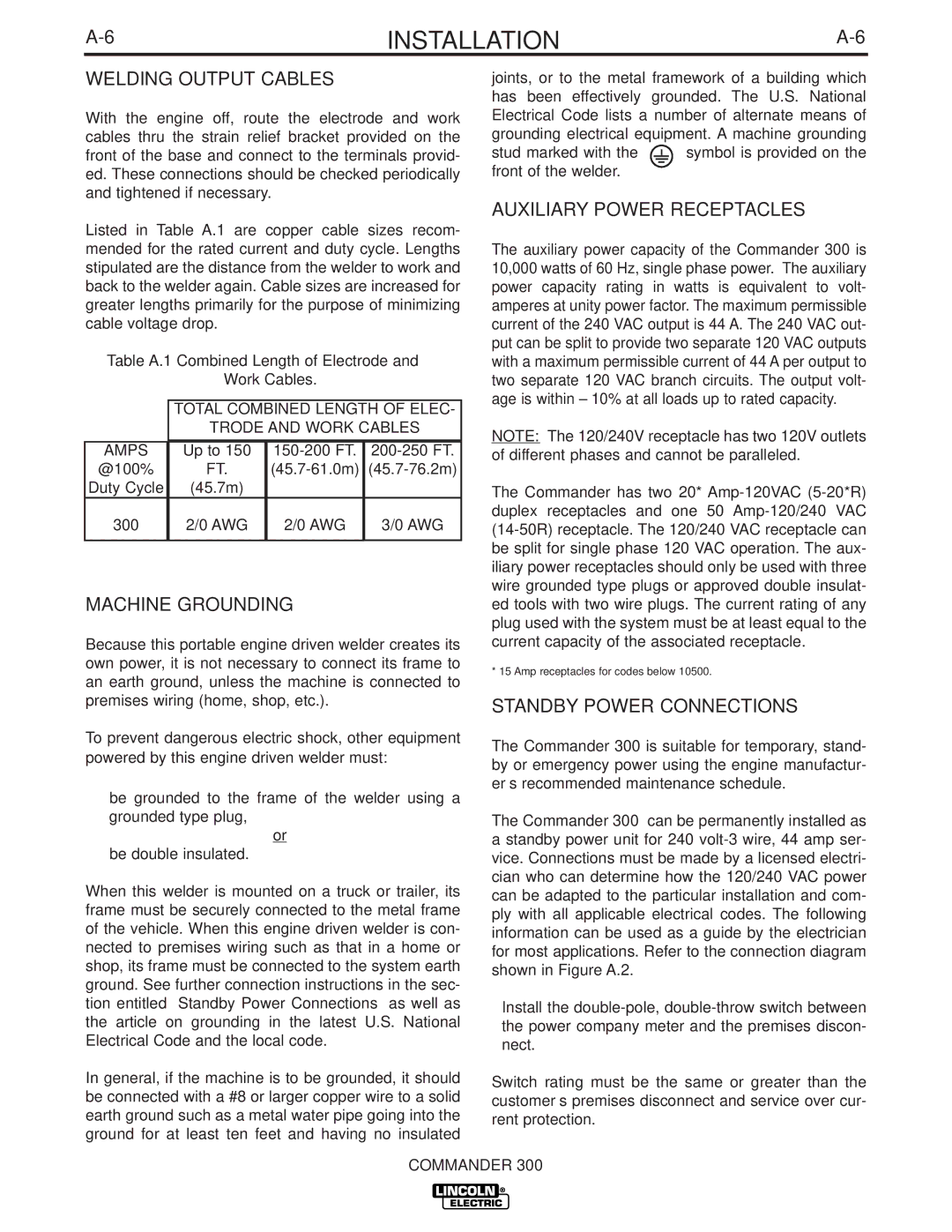
INSTALLATION | ||
|
|
|
WELDING OUTPUT CABLES
With the engine off, route the electrode and work cables thru the strain relief bracket provided on the front of the base and connect to the terminals provid- ed. These connections should be checked periodically and tightened if necessary.
joints, or to the metal framework of a building which has been effectively grounded. The U.S. National Electrical Code lists a number of alternate means of grounding electrical equipment. A machine grounding
stud marked with the ![]() symbol is provided on the front of the welder.
symbol is provided on the front of the welder.
Listed in Table A.1 are copper cable sizes recom- mended for the rated current and duty cycle. Lengths stipulated are the distance from the welder to work and back to the welder again. Cable sizes are increased for greater lengths primarily for the purpose of minimizing cable voltage drop.
Table A.1 Combined Length of Electrode and
Work Cables.
| TOTAL COMBINED LENGTH OF ELEC- | ||
| TRODE AND WORK CABLES | ||
|
|
|
|
AMPS | Up to 150 | ||
@100% | FT. | ||
Duty Cycle | (45.7m) |
|
|
300 | 2/0 AWG | 2/0 AWG | 3/0 AWG |
|
|
|
|
MACHINE GROUNDING
Because this portable engine driven welder creates its own power, it is not necessary to connect its frame to an earth ground, unless the machine is connected to premises wiring (home, shop, etc.).
To prevent dangerous electric shock, other equipment powered by this engine driven welder must:
•be grounded to the frame of the welder using a grounded type plug,
or
•be double insulated.
When this welder is mounted on a truck or trailer, its frame must be securely connected to the metal frame of the vehicle. When this engine driven welder is con- nected to premises wiring such as that in a home or shop, its frame must be connected to the system earth ground. See further connection instructions in the sec- tion entitled “Standby Power Connections” as well as the article on grounding in the latest U.S. National Electrical Code and the local code.
In general, if the machine is to be grounded, it should be connected with a #8 or larger copper wire to a solid earth ground such as a metal water pipe going into the ground for at least ten feet and having no insulated
AUXILIARY POWER RECEPTACLES
The auxiliary power capacity of the Commander 300 is 10,000 watts of 60 Hz, single phase power. The auxiliary power capacity rating in watts is equivalent to volt- amperes at unity power factor. The maximum permissible current of the 240 VAC output is 44 A. The 240 VAC out- put can be split to provide two separate 120 VAC outputs with a maximum permissible current of 44 A per output to two separate 120 VAC branch circuits. The output volt- age is within ± 10% at all loads up to rated capacity.
NOTE: The 120/240V receptacle has two 120V outlets of different phases and cannot be paralleled.
The Commander has two 20*
* 15 Amp receptacles for codes below 10500.
STANDBY POWER CONNECTIONS
The Commander 300 is suitable for temporary, stand- by or emergency power using the engine manufactur- er’s recommended maintenance schedule.
The Commander 300 can be permanently installed as a standby power unit for 240
•Install the
Switch rating must be the same or greater than the customer’s premises disconnect and service over cur- rent protection.
COMMANDER 300
